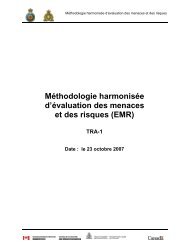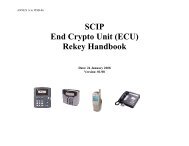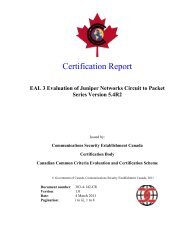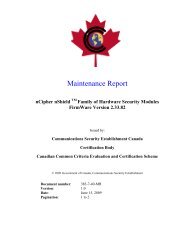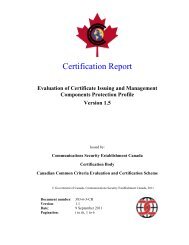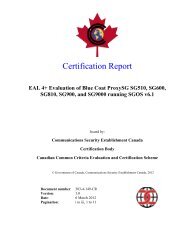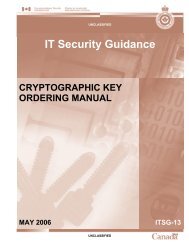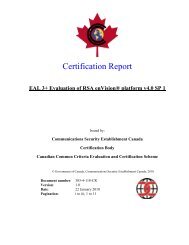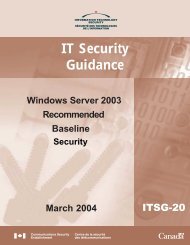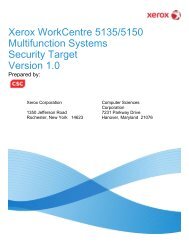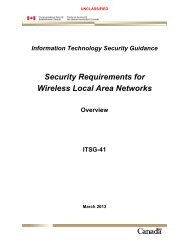Security of BlackBerry PIN-to-PIN Messaging - Centre de la sécurité ...
Security of BlackBerry PIN-to-PIN Messaging - Centre de la sécurité ...
Security of BlackBerry PIN-to-PIN Messaging - Centre de la sécurité ...
Create successful ePaper yourself
Turn your PDF publications into a flip-book with our unique Google optimized e-Paper software.
UNCLASSIFIED/NON CLASSIFIÉ<br />
IT <strong>Security</strong> Bulletin<br />
Bulletin <strong>de</strong> sécurité TI<br />
March 2011 ITSB-57B Mars 2011<br />
<strong>Security</strong> <strong>of</strong> <strong>B<strong>la</strong>ckBerry</strong><br />
<strong>PIN</strong>-<strong>to</strong>-<strong>PIN</strong> <strong>Messaging</strong><br />
Sécurité <strong>de</strong> <strong>la</strong> messagerie<br />
<strong>B<strong>la</strong>ckBerry</strong> NIP à NIP<br />
Purpose<br />
The purpose <strong>of</strong> this Bulletin is <strong>to</strong> advise<br />
Government <strong>of</strong> Canada (GC) <strong>de</strong>partments<br />
and agencies <strong>of</strong> the security vulnerabilities<br />
arising from the use <strong>of</strong> the <strong>B<strong>la</strong>ckBerry</strong> <strong>PIN</strong><strong>to</strong>-<strong>PIN</strong><br />
messaging service.<br />
Background<br />
The CSEC document entitled ITSPSR-18A<br />
“Smartphone Vulnerability Assessment”<br />
discusses security issues with smartphones.<br />
As exp<strong>la</strong>ined in this document, the<br />
Research-In-Motion (RIM) <strong>B<strong>la</strong>ckBerry</strong><br />
<strong>de</strong>vice <strong>of</strong>fers two types <strong>of</strong> communication:<br />
• Voice – a built-in cellu<strong>la</strong>r telephone<br />
allows the user <strong>to</strong> make voice calls.<br />
<strong>Security</strong> features avai<strong>la</strong>ble for voice<br />
calls <strong>de</strong>pend on the cellu<strong>la</strong>r technology<br />
(i.e. GSM or CDMA) used in the<br />
particu<strong>la</strong>r <strong>B<strong>la</strong>ckBerry</strong> mo<strong>de</strong>l and<br />
features supported by the cellu<strong>la</strong>r<br />
carrier; no additional security for voice<br />
calls is provi<strong>de</strong>d by the <strong>B<strong>la</strong>ckBerry</strong>; and<br />
Objet<br />
Le présent bulletin a pour objet d’informer les ministères<br />
et organismes du gouvernement du Canada (GC) <strong>de</strong>s<br />
vulnérabilités en matière <strong>de</strong> sécurité résultant <strong>de</strong><br />
l’utilisation du service <strong>de</strong> messagerie NIP à NIP du<br />
<strong>B<strong>la</strong>ckBerry</strong>.<br />
Contexte<br />
Le document ITSPSR-18A du <strong>Centre</strong> <strong>de</strong> <strong>la</strong> sécurité <strong>de</strong>s<br />
télécommunications Canada (CSTC) intitulé Évaluation<br />
<strong>de</strong>s vulnérabilités <strong>de</strong>s téléphones intelligents traite <strong>de</strong>s<br />
problèmes <strong>de</strong> sécurité liés aux téléphones intelligents. Tel<br />
qu’il est expliqué dans le document, le dispositif<br />
<strong>B<strong>la</strong>ckBerry</strong> <strong>de</strong> Research-In-Motion (RIM) <strong>of</strong>fre <strong>de</strong>ux<br />
types <strong>de</strong> communications:<br />
• Communications vocales – Un téléphone cellu<strong>la</strong>ire<br />
intégré permet à l’utilisateur d’établir <strong>de</strong>s<br />
communications vocales. Les fonctions <strong>de</strong> sécurité<br />
disponibles pour les communications vocales<br />
dépen<strong>de</strong>nt <strong>de</strong> <strong>la</strong> technologie cellu<strong>la</strong>ire (c.-à-d. GSM<br />
ou AMRC) utilisée dans le modèle <strong>B<strong>la</strong>ckBerry</strong><br />
particulier et <strong>de</strong>s fonctions prises en charge par<br />
l’entreprise <strong>de</strong> téléphonie cellu<strong>la</strong>ire; le <strong>B<strong>la</strong>ckBerry</strong><br />
n’<strong>of</strong>fre aucune sécurité additionnelle pour les<br />
communications vocales;<br />
1<br />
UNCLASSIFIED/NON CLASSIFIÉ
UNCLASSIFIED/NON CLASSIFIÉ<br />
March 2011 ITSB-57B Mars 2011<br />
• Data – the <strong>B<strong>la</strong>ckBerry</strong> allows e-mail<br />
and other data transmissions (including<br />
<strong>PIN</strong>-<strong>to</strong>-<strong>PIN</strong>, Internet browsing, and<br />
other voice-data service messages) <strong>to</strong> be<br />
sent over the air. As for voice, security<br />
features for data transmissions <strong>de</strong>pend<br />
on the cellu<strong>la</strong>r technology (e.g.,<br />
Mobitex, GPRS/EDGE, 1xRTT,<br />
HSDPA, etc.) and features supported by<br />
the carrier/service provi<strong>de</strong>r for each<br />
particu<strong>la</strong>r mo<strong>de</strong>l <strong>of</strong> <strong>B<strong>la</strong>ckBerry</strong> <strong>de</strong>vice,<br />
but in the case <strong>of</strong> data, transmissions<br />
may also be further encrypted by the<br />
<strong>B<strong>la</strong>ckBerry</strong> <strong>de</strong>vice for ad<strong>de</strong>d security.<br />
This Bulletin will focus on threats <strong>to</strong> the<br />
security <strong>of</strong> data transmissions re<strong>la</strong>ted<br />
specifically <strong>to</strong> <strong>PIN</strong>-<strong>to</strong>-<strong>PIN</strong> communications<br />
on <strong>B<strong>la</strong>ckBerry</strong> <strong>de</strong>vices. GC clients<br />
interested in further <strong>de</strong>tails on other aspects<br />
<strong>of</strong> <strong>B<strong>la</strong>ckBerry</strong> and smartphone security are<br />
advised <strong>to</strong> refer <strong>to</strong> ITSPSR-18A or <strong>to</strong><br />
contact CSEC Client Services.<br />
<strong>B<strong>la</strong>ckBerry</strong> Internet Service (BIS) vs.<br />
<strong>B<strong>la</strong>ckBerry</strong> Enterprise Server (BES)<br />
<strong>B<strong>la</strong>ckBerry</strong> <strong>de</strong>vices sold through wireless<br />
service provi<strong>de</strong>rs may be used with the<br />
consumer service (<strong>B<strong>la</strong>ckBerry</strong> Internet<br />
Service (BIS), the service <strong>of</strong>fered with most<br />
privately-owned <strong>de</strong>vices) or with the<br />
enterprise service (<strong>B<strong>la</strong>ckBerry</strong> Enterprise<br />
Server, commonly known as BES).<br />
• Communications <strong>de</strong> données – Le <strong>B<strong>la</strong>ckBerry</strong><br />
permet <strong>la</strong> transmission par on<strong>de</strong>s hertziennes <strong>de</strong><br />
courriels et d’autres données (y compris NIP à NIP, <strong>la</strong><br />
navigation dans Internet, et d’autres messages <strong>de</strong><br />
service voix-données). Comme pour les<br />
communications vocales, les fonctions <strong>de</strong> sécurité<br />
liées aux transmissions <strong>de</strong> données dépen<strong>de</strong>nt <strong>de</strong> <strong>la</strong><br />
technologie cellu<strong>la</strong>ire (p. ex., Mobitex, GPRS/EDGE,<br />
1xRTT, HSDPA, etc.) utilisée et <strong>de</strong>s fonctions prises<br />
en charge par l’entreprise <strong>de</strong> téléphonie cellu<strong>la</strong>ire ou<br />
le fournisseur <strong>de</strong> services pour chaque modèle<br />
<strong>B<strong>la</strong>ckBerry</strong>, mais les données peuvent être également<br />
chiffrées par le dispositif <strong>B<strong>la</strong>ckBerry</strong> comme sécurité<br />
additionnelle.<br />
Le présent bulletin porte principalement sur les menaces<br />
envers <strong>la</strong> sécurité <strong>de</strong>s transmissions <strong>de</strong> données en ce qui<br />
a trait aux communications NIP à NIP sur les dispositifs<br />
<strong>B<strong>la</strong>ckBerry</strong>. Les clients du GC intéressés à se renseigner<br />
davantage sur les autres aspects <strong>de</strong> <strong>la</strong> sécurité du<br />
<strong>B<strong>la</strong>ckBerry</strong> et <strong>de</strong>s téléphones intelligents sont priés <strong>de</strong> se<br />
reporter à l’ITSPSR-18A ou <strong>de</strong> communiquer avec les<br />
Services à <strong>la</strong> clientèle du CSTC.<br />
Service Internet <strong>B<strong>la</strong>ckBerry</strong> (BIS) et Serveur<br />
d’entreprise <strong>B<strong>la</strong>ckBerry</strong> (BES)<br />
Les dispositifs <strong>B<strong>la</strong>ckBerry</strong> vendus par l’entremise <strong>de</strong>s<br />
fournisseurs <strong>de</strong> services sans fil peuvent être utilisés en<br />
conjonction avec le service <strong>de</strong> consommation (Service<br />
Internet <strong>B<strong>la</strong>ckBerry</strong> ou BIS pour <strong>B<strong>la</strong>ckBerry</strong> Internet<br />
Service, service <strong>of</strong>fert avec <strong>la</strong> majorité <strong>de</strong>s dispositifs<br />
privés) ou avec le service d’entreprise (Serveur<br />
d’entreprise <strong>B<strong>la</strong>ckBerry</strong> Enterprise ou BES pour<br />
<strong>B<strong>la</strong>ckBerry</strong> Enterprise Server).<br />
From a basic security perspective, the BES<br />
inclu<strong>de</strong>s supplementary encryption and data<br />
protection for enterprise <strong>B<strong>la</strong>ckBerry</strong> <strong>de</strong>vice<br />
users, whereas the BIS does not. From a<br />
connectivity perspective, the BES allows<br />
<strong>B<strong>la</strong>ckBerry</strong> <strong>de</strong>vices <strong>to</strong> be connected <strong>to</strong><br />
Du point <strong>de</strong> vue <strong>de</strong> <strong>la</strong> sécurité <strong>de</strong> base, le BES comprend<br />
un chiffrement et une protection <strong>de</strong>s données additionnels<br />
pour les utilisateurs <strong>de</strong> dispositifs <strong>B<strong>la</strong>ckBerry</strong><br />
d’entreprise, tandis que le BIS n’en comprend pas. Du<br />
point <strong>de</strong> vue <strong>de</strong> <strong>la</strong> connectivité, le BES permet aux<br />
dispositifs <strong>B<strong>la</strong>ckBerry</strong> <strong>de</strong> se connecter aux serveurs <strong>de</strong><br />
2<br />
UNCLASSIFIED/NON CLASSIFIÉ
UNCLASSIFIED/NON CLASSIFIÉ<br />
March 2011 ITSB-57B Mars 2011<br />
<strong>de</strong>partmental mail servers and <strong>to</strong> access<br />
internal services.<br />
While there are several methods that may<br />
be used, CSEC recommends using the BES<br />
<strong>to</strong> comply with the data protection<br />
requirements <strong>of</strong> the Policy on Government<br />
<strong>Security</strong> (PGS). The rest <strong>of</strong> this Bulletin<br />
assumes that the BES is being used.<br />
E-mail and <strong>PIN</strong>-<strong>to</strong>-<strong>PIN</strong> <strong>Messaging</strong><br />
Differences<br />
Figure 1 illustrates the components<br />
involved in sending or receiving e-mail<br />
messages on an enterprise <strong>B<strong>la</strong>ckBerry</strong><br />
<strong>de</strong>vice.<br />
courriel <strong>de</strong> l’entreprise et d’accé<strong>de</strong>r aux services internes.<br />
Bien qu’il existe plusieurs métho<strong>de</strong>s, CSTC recomman<strong>de</strong><br />
l’utilisation du BES afin <strong>de</strong> respecter les exigences en<br />
matière <strong>de</strong> protection <strong>de</strong> données <strong>de</strong> <strong>la</strong> Politique sur <strong>la</strong><br />
sécurité du gouvernement (PSG). Le reste du bulletin<br />
repose sur l’hypothèse qu’on utilise le BES.<br />
Différences entre les courriels et les messages<br />
NIP à NIP<br />
La figure 1 illustre les composants qui entrent en jeu<br />
lorsqu’on envoie ou qu’on reçoit un courriel à l'ai<strong>de</strong> d'un<br />
dispositif <strong>B<strong>la</strong>ckBerry</strong> d’entreprise.<br />
Figure 1 - Sending/Receiving E-mail on a <strong>B<strong>la</strong>ckBerry</strong> <strong>de</strong>vice using a BES<br />
Envoi et réception <strong>de</strong>s courriels sur un dispositif <strong>B<strong>la</strong>ckBerry</strong> en utilisant un BES<br />
As shown in Figure 1, e-mail messages sent<br />
from a <strong>B<strong>la</strong>ckBerry</strong> <strong>de</strong>vice are first AESencrypted,<br />
and passed <strong>to</strong> the user’s wireless<br />
service provi<strong>de</strong>r (a), which then forwards the<br />
message <strong>to</strong> one <strong>of</strong> the global re<strong>la</strong>y servers<br />
operated by RIM (b). The RIM re<strong>la</strong>y passes the<br />
Comme il est illustré dans <strong>la</strong> figure 1, un courriel<br />
envoyé à partir d’un dispositif <strong>B<strong>la</strong>ckBerry</strong> est <strong>to</strong>ut<br />
d’abord chiffré à l’ai<strong>de</strong> <strong>de</strong> AES et transmis au<br />
fournisseur <strong>de</strong> services sans fil <strong>de</strong> l’expéditeur (a), qui<br />
l’achemine ensuite à l’un <strong>de</strong>s serveurs <strong>de</strong> re<strong>la</strong>is globaux<br />
exploité par RIM (b). La station <strong>de</strong> re<strong>la</strong>is RIM transmet<br />
3<br />
UNCLASSIFIED/NON CLASSIFIÉ
UNCLASSIFIED/NON CLASSIFIÉ<br />
March 2011 ITSB-57B Mars 2011<br />
message via Internet on <strong>to</strong> the <strong>de</strong>partmental<br />
<strong>B<strong>la</strong>ckBerry</strong> Enterprise Server (BES) <strong>of</strong> the<br />
originating user (c), which <strong>de</strong>crypts it and<br />
forwards it <strong>to</strong> the <strong>de</strong>partmental mail server (d)<br />
for <strong>de</strong>livery <strong>to</strong> the <strong>de</strong>stination user (so that an e-<br />
mail from an enterprise <strong>B<strong>la</strong>ckBerry</strong> <strong>de</strong>vice<br />
actually appears <strong>to</strong> have originated from insi<strong>de</strong><br />
the <strong>de</strong>partmental network, e). If the <strong>de</strong>stination<br />
user is not in the same <strong>de</strong>partment as the<br />
originating user, the e-mail will travel through<br />
the Internet <strong>to</strong> the <strong>de</strong>stination user’s network<br />
for <strong>de</strong>livery (f). Further, if the <strong>de</strong>stination user<br />
is also a <strong>B<strong>la</strong>ckBerry</strong> <strong>de</strong>vice user, the <strong>de</strong>stination<br />
<strong>of</strong>fice will have its own BES which will<br />
forward an encrypted copy <strong>of</strong> the e-mail over<br />
the Internet (g) <strong>to</strong> the RIM re<strong>la</strong>y for <strong>de</strong>livery <strong>to</strong><br />
the <strong>de</strong>stination user’s <strong>B<strong>la</strong>ckBerry</strong> <strong>de</strong>vice (h).<br />
<strong>B<strong>la</strong>ckBerry</strong> <strong>PIN</strong>-<strong>to</strong>-<strong>PIN</strong> (sometimes referred <strong>to</strong><br />
as Peer-<strong>to</strong>-Peer) messaging is simi<strong>la</strong>r <strong>to</strong> e-mail<br />
in that it allows <strong>B<strong>la</strong>ckBerry</strong> <strong>de</strong>vice users <strong>to</strong><br />
send messages <strong>to</strong> each other, but with important<br />
differences:<br />
• Only possible between <strong>B<strong>la</strong>ckBerry</strong> <strong>de</strong>vices<br />
• Addressed <strong>to</strong> a “<strong>PIN</strong>” instead <strong>of</strong> an e-mail<br />
address. A “<strong>PIN</strong>” is a hardware address,<br />
simi<strong>la</strong>r <strong>to</strong> a computer network adapter’s<br />
MAC address, and is unique <strong>to</strong> every<br />
<strong>B<strong>la</strong>ckBerry</strong> <strong>de</strong>vice. A “<strong>PIN</strong>” is not an<br />
authentication password nor is it a user<br />
i<strong>de</strong>ntifier. It is the method by which the<br />
<strong>B<strong>la</strong>ckBerry</strong> <strong>de</strong>vice is i<strong>de</strong>ntified <strong>to</strong> the RIM<br />
re<strong>la</strong>y for the purpose <strong>of</strong> finding the <strong>de</strong>vice<br />
within the global wireless service provi<strong>de</strong>rs’<br />
networks.<br />
If permitted by <strong>de</strong>partmental policy, users<br />
who know the <strong>PIN</strong>s <strong>of</strong> other users’<br />
<strong>B<strong>la</strong>ckBerry</strong> <strong>de</strong>vice can use the <strong>PIN</strong>s <strong>to</strong><br />
directly exchange data messages with the<br />
other <strong>de</strong>vices across the wireless network<br />
le message au serveur d’entreprise <strong>B<strong>la</strong>ckBerry</strong><br />
ministériel <strong>de</strong> l’expéditeur (c), qui le déchiffre et<br />
l’achemine par Internet vers le serveur <strong>de</strong> courriel<br />
ministériel (d) afin qu’il soit livré au <strong>de</strong>stinataire (<strong>de</strong><br />
sorte que le courriel d’un dispositif <strong>B<strong>la</strong>ckBerry</strong><br />
d’entreprise semble provenir <strong>de</strong> l’intérieur du réseau<br />
ministériel [e]). Si le <strong>de</strong>stinataire n’est pas dans le<br />
même ministère que l’expéditeur, le courriel passera par<br />
Internet pour être livré au réseau du <strong>de</strong>stinataire (f). Par<br />
ailleurs, si le <strong>de</strong>stinataire est également un utilisateur <strong>de</strong><br />
dispositif <strong>B<strong>la</strong>ckBerry</strong>, le bureau du <strong>de</strong>stinataire aura son<br />
propre BES qui transmettra par Internet (g) une copie<br />
chiffrée du courriel au re<strong>la</strong>is RIM pour être livré au<br />
dispositif <strong>B<strong>la</strong>ckBerry</strong> du <strong>de</strong>stinataire (h).<br />
La messagerie <strong>B<strong>la</strong>ckBerry</strong> NIP à NIP (parfois appelée<br />
« poste à poste ») est semb<strong>la</strong>ble au courriel en ce sens<br />
qu’elle permet également aux utilisateurs <strong>de</strong> dispositifs<br />
<strong>B<strong>la</strong>ckBerry</strong> <strong>de</strong> s’envoyer <strong>de</strong>s messages entre eux, mais<br />
elle comporte <strong>de</strong>s différences importantes :<br />
• La messagerie NIP à NIP n’est possible qu’entre<br />
dispositifs <strong>B<strong>la</strong>ckBerry</strong>.<br />
• Le message doit être adressé à un NIP plutôt qu’à<br />
une adresse <strong>de</strong> courriel. Le NIP est une adresse<br />
matérielle, semb<strong>la</strong>ble à l’adresse MAC <strong>de</strong> <strong>la</strong> carte<br />
réseau d’un ordinateur, et elle est unique à chaque<br />
dispositif <strong>B<strong>la</strong>ckBerry</strong>. Le NIP n’est pas un mot <strong>de</strong><br />
passe d’authentification, ni l’i<strong>de</strong>ntificateur d’un<br />
utilisateur. C’est <strong>la</strong> métho<strong>de</strong> par <strong>la</strong>quelle le re<strong>la</strong>is<br />
RIM i<strong>de</strong>ntifie le dispositif <strong>B<strong>la</strong>ckBerry</strong> aux fins <strong>de</strong><br />
localisation dans les réseaux globaux <strong>de</strong>s<br />
fournisseurs <strong>de</strong> services sans fil.<br />
4<br />
Si <strong>la</strong> politique ministérielle l’au<strong>to</strong>rise, les<br />
utilisateurs qui connaissent le NIP du dispositif<br />
<strong>B<strong>la</strong>ckBerry</strong> d’autres utilisateurs peuvent l’utiliser<br />
pour échanger directement <strong>de</strong>s messages <strong>de</strong> données<br />
avec ces dispositifs à l’intérieur du réseau sans fil (à<br />
UNCLASSIFIED/NON CLASSIFIÉ
UNCLASSIFIED/NON CLASSIFIÉ<br />
March 2011 ITSB-57B Mars 2011<br />
(outsi<strong>de</strong> the normal e-mail process), thus<br />
bypassing the internal <strong>de</strong>partmental e-mail<br />
servers and security filters.<br />
Figure 2 illustrates the process <strong>of</strong> sending or<br />
receiving <strong>PIN</strong>-<strong>to</strong>-<strong>PIN</strong> messages on a<br />
<strong>B<strong>la</strong>ckBerry</strong> <strong>de</strong>vice.<br />
l’extérieur du processus <strong>de</strong> courriel régulier),<br />
con<strong>to</strong>urnant par le fait même les serveurs <strong>de</strong> courriel<br />
et les filtres <strong>de</strong> sécurité internes du ministère.<br />
La figure 2 illustre le processus d’envoi et <strong>de</strong> réception<br />
<strong>de</strong> messages NIP à NIP sur un dispositif <strong>B<strong>la</strong>ckBerry</strong>.<br />
Figure 2- Sending/Receiving <strong>PIN</strong>-<strong>to</strong>-<strong>PIN</strong> Messages on a <strong>B<strong>la</strong>ckBerry</strong> <strong>de</strong>vice<br />
Envoi et réception <strong>de</strong> messages NIP à NIP sur un <strong>B<strong>la</strong>ckBerry</strong><br />
In this case, a <strong>PIN</strong>-<strong>to</strong>-<strong>PIN</strong> message sent from a<br />
<strong>B<strong>la</strong>ckBerry</strong> <strong>de</strong>vice is forwar<strong>de</strong>d <strong>to</strong> the RIM re<strong>la</strong>y<br />
(a) by the user’s wireless service provi<strong>de</strong>r as in<br />
the case <strong>of</strong> e-mail. However, for a <strong>PIN</strong>-<strong>to</strong>-<strong>PIN</strong><br />
message, instead <strong>of</strong> going back through<br />
<strong>de</strong>partmental e-mail servers, the re<strong>la</strong>y i<strong>de</strong>ntifies<br />
the <strong>de</strong>stination <strong>B<strong>la</strong>ckBerry</strong> <strong>de</strong>vice by its <strong>PIN</strong> and<br />
forwards the message directly <strong>to</strong> the <strong>de</strong>stination<br />
user’s wireless service provi<strong>de</strong>r (which may or<br />
may not be the same provi<strong>de</strong>r as the originating<br />
user, b) for direct <strong>de</strong>livery <strong>to</strong> the <strong>de</strong>stination<br />
<strong>de</strong>vice (c).<br />
BES version 4.1 and <strong>la</strong>ter provi<strong>de</strong>s a solution<br />
whereby <strong>de</strong>partments that permit the use <strong>of</strong> <strong>PIN</strong><strong>to</strong>-<strong>PIN</strong><br />
messaging can configure the BES <strong>to</strong> force<br />
corporate <strong>B<strong>la</strong>ckBerry</strong> <strong>de</strong>vices <strong>to</strong> send copies <strong>of</strong><br />
Dans ce cas-ci, un message NIP à NIP envoyé à partir<br />
d’un dispositif <strong>B<strong>la</strong>ckBerry</strong> est acheminé au re<strong>la</strong>is RIM<br />
(a) par le fournisseur <strong>de</strong> services sans fil <strong>de</strong><br />
l’expéditeur comme dans le cas d’un courriel.<br />
Toutefois, au lieu <strong>de</strong> passer par les serveurs <strong>de</strong><br />
courriel du ministère, le re<strong>la</strong>is i<strong>de</strong>ntifie le dispositif<br />
<strong>B<strong>la</strong>ckBerry</strong> <strong>de</strong> <strong>de</strong>stination par son NIP et achemine<br />
directement le message au fournisseur <strong>de</strong> services<br />
sans fil du <strong>de</strong>stinataire (qui pourrait être différent <strong>de</strong><br />
celui <strong>de</strong> l’expéditeur [b]) aux fins <strong>de</strong> livraison directe<br />
au dispositif <strong>de</strong> <strong>de</strong>stination (c).<br />
Les versions 4.1 et ultérieures du BES <strong>of</strong>frent une<br />
solution permettant à un ministère qui au<strong>to</strong>rise <strong>la</strong><br />
messagerie NIP à NIP <strong>de</strong> configurer son BES <strong>de</strong> façon<br />
à forcer les dispositifs <strong>B<strong>la</strong>ckBerry</strong> du ministère à<br />
5<br />
UNCLASSIFIED/NON CLASSIFIÉ
UNCLASSIFIED/NON CLASSIFIÉ<br />
March 2011 ITSB-57B Mars 2011<br />
their <strong>PIN</strong>, SMS, or MMS transmissions <strong>to</strong> the<br />
BES. The <strong>de</strong>partmental BES can then s<strong>to</strong>re those<br />
messages <strong>to</strong> help <strong>de</strong>partments meet audit<br />
requirements.<br />
<strong>PIN</strong>-<strong>to</strong>-<strong>PIN</strong> <strong>Security</strong> Issues<br />
<strong>PIN</strong>-<strong>to</strong>-<strong>PIN</strong> messaging is typically faster than the<br />
normal e-mail process as the message passes<br />
through fewer servers and infrastructure<br />
components. For this reason, <strong>PIN</strong>-<strong>to</strong>-<strong>PIN</strong><br />
messages are also useful for emergency<br />
communications in situations where the<br />
<strong>de</strong>partmental e-mail servers are down, but the<br />
wireless service provi<strong>de</strong>r and RIM re<strong>la</strong>y are still<br />
avai<strong>la</strong>ble. However, if the wireless carrier’s<br />
cellu<strong>la</strong>r network (e.g., Rogers, Bell, etc.) is also<br />
down, then <strong>PIN</strong>-<strong>to</strong>-<strong>PIN</strong> messaging will also be<br />
unavai<strong>la</strong>ble. Unfortunately, <strong>PIN</strong>-<strong>to</strong>-<strong>PIN</strong><br />
messaging suffers from several important<br />
security vulnerabilities that GC users should be<br />
aware <strong>of</strong>:<br />
1. <strong>PIN</strong>-<strong>to</strong>-<strong>PIN</strong> transmission security: <strong>PIN</strong>-<strong>to</strong>-<br />
<strong>PIN</strong> is not suitable for exchanging sensitive<br />
messages. Although <strong>PIN</strong>-<strong>to</strong>-<strong>PIN</strong> messages are<br />
encrypted using Triple-DES, the key used is a<br />
global cryp<strong>to</strong>graphic “key” that is common <strong>to</strong><br />
every <strong>B<strong>la</strong>ckBerry</strong> <strong>de</strong>vice all over the world.<br />
This means any <strong>B<strong>la</strong>ckBerry</strong> <strong>de</strong>vice can<br />
potentially <strong>de</strong>crypt all <strong>PIN</strong>-<strong>to</strong>-<strong>PIN</strong> messages<br />
sent by any other <strong>B<strong>la</strong>ckBerry</strong> <strong>de</strong>vice, if the<br />
messages can be intercepted and the<br />
<strong>de</strong>stination <strong>PIN</strong> spo<strong>of</strong>ed. Further, unfriendly<br />
third parties who know the key could<br />
potentially use it <strong>to</strong> <strong>de</strong>crypt messages<br />
captured over the air. Note that the<br />
“<strong>B<strong>la</strong>ckBerry</strong> Solution <strong>Security</strong> Technical<br />
Overview” [1] document published by RIM<br />
specifically advises users <strong>to</strong> “consi<strong>de</strong>r <strong>PIN</strong><br />
messages as scrambled, not encrypted”.<br />
envoyer au BES une copie <strong>de</strong> leurs transmissions NIP,<br />
SMS ou MMS. Le BES ministériel peut ensuite<br />
s<strong>to</strong>cker ces messages pour ai<strong>de</strong>r le ministère à<br />
satisfaire aux exigences en matière <strong>de</strong> vérification.<br />
Problèmes liés à <strong>la</strong> sécurité <strong>de</strong> <strong>la</strong> messagerie<br />
NIP à NIP<br />
La messagerie NIP à NIP est généralement plus rapi<strong>de</strong><br />
que le processus normal d’acheminement <strong>de</strong> courriels<br />
car elle fait appel à un plus petit nombre <strong>de</strong> serveurs et<br />
<strong>de</strong> composants d’infrastructure. Pour cette raison, les<br />
messages NIP à NIP sont également utiles pour les<br />
communications d’urgence dans <strong>de</strong>s situations où les<br />
serveurs ministériels sont en panne, mais où le<br />
fournisseur <strong>de</strong> services sans fil et le re<strong>la</strong>is RIM sont<br />
<strong>to</strong>ujours disponibles. Toutefois, si le réseau cellu<strong>la</strong>ire<br />
<strong>de</strong> l’entreprise sans fil (p. ex., Rogers, Bell, etc.) est<br />
également en panne, <strong>la</strong> messagerie NIP à NIP ne sera<br />
pas disponible non plus. Malheureusement, <strong>la</strong><br />
messagerie NIP à NIP présente <strong>de</strong> nombreuses<br />
vulnérabilités importantes en matière <strong>de</strong> sécurité que<br />
les utilisateurs du GC <strong>de</strong>vraient connaître :<br />
1. Sécurité <strong>de</strong> transmission NIP à NIP : La<br />
messagerie NIP à NIP ne convient pas à l’échange<br />
<strong>de</strong> messages sensibles. Quoique les messages NIP<br />
à NIP soient chiffrés à l’ai<strong>de</strong> <strong>de</strong> Triple-DES, <strong>la</strong> clé<br />
utilisée est une clé cryp<strong>to</strong>graphique générale<br />
commune à <strong>to</strong>us les dispositifs <strong>B<strong>la</strong>ckBerry</strong> à<br />
travers le mon<strong>de</strong>. En d’autres mots, <strong>to</strong>ut dispositif<br />
<strong>B<strong>la</strong>ckBerry</strong> est capable <strong>de</strong> déchiffrer <strong>to</strong>us les<br />
messages NIP à NIP envoyés par un autre<br />
dispositif <strong>B<strong>la</strong>ckBerry</strong>, si ces messages peuvent<br />
être interceptés et le NIP <strong>de</strong> <strong>de</strong>stination usurpé.<br />
Par ailleurs, <strong>de</strong>s parties hostiles qui connaissent <strong>la</strong><br />
clé pourraient s’en servir pour déchiffrer <strong>de</strong>s<br />
messages captés en direct. À noter que le<br />
document <strong>B<strong>la</strong>ckBerry</strong> Solution <strong>Security</strong> Technical<br />
Overview [1] publié par RIM conseille aux<br />
utilisateurs <strong>de</strong> considérer les messages NIP<br />
comme étant brouillés, et non chiffrés.<br />
6<br />
UNCLASSIFIED/NON CLASSIFIÉ
UNCLASSIFIED/NON CLASSIFIÉ<br />
March 2011 ITSB-57B Mars 2011<br />
2. <strong>PIN</strong> Address Vulnerability: A <strong>B<strong>la</strong>ckBerry</strong><br />
<strong>de</strong>vice that has been used for <strong>PIN</strong> messaging<br />
should not be recycled for re-use. The reason<br />
is that the hard-co<strong>de</strong>d <strong>PIN</strong> cannot be erased<br />
or modified, and therefore the <strong>PIN</strong> does not<br />
follow a user <strong>to</strong> a new <strong>de</strong>vice. Even after<br />
memory wiping and reloading, the<br />
<strong>B<strong>la</strong>ckBerry</strong> <strong>de</strong>vice still has the same <strong>PIN</strong><br />
i<strong>de</strong>ntity and will continue <strong>to</strong> receive <strong>PIN</strong><br />
messages addressed <strong>to</strong> that <strong>PIN</strong>. This can<br />
expose unsuspecting users <strong>of</strong> <strong>B<strong>la</strong>ckBerry</strong><br />
<strong>de</strong>vices <strong>to</strong> potential information compromise<br />
in the following ways:<br />
• A new owner <strong>of</strong> the recycled <strong>B<strong>la</strong>ckBerry</strong><br />
<strong>de</strong>vice could view <strong>PIN</strong> messages sent<br />
from a colleague <strong>of</strong> the previous owner<br />
who is unaware that the message is now<br />
going <strong>to</strong> the wrong recipient (recall that<br />
the <strong>PIN</strong> is a <strong>de</strong>vice ID, and not a user ID).<br />
• A message sent by the <strong>B<strong>la</strong>ckBerry</strong><br />
<strong>de</strong>vice’s new owner contains a known <strong>PIN</strong><br />
cre<strong>de</strong>ntial which might be mistakenly<br />
accepted as being from the previous owner<br />
(impersonation).<br />
3. Bypass <strong>of</strong> Virus/Malware Scanning and<br />
Spam Filtering mechanisms: As <strong>de</strong>scribed<br />
previously, <strong>PIN</strong>-<strong>to</strong>-<strong>PIN</strong> messaging bypasses<br />
all corporate e-mail security filters, and thus<br />
users may become vulnerable <strong>to</strong> viruses and<br />
malware co<strong>de</strong> as well as spam messages if<br />
their <strong>PIN</strong> becomes known <strong>to</strong> unauthorized<br />
third parties.<br />
Recommendations<br />
GC <strong>de</strong>partments are advised <strong>to</strong> consi<strong>de</strong>r all the<br />
aforementioned security issues before allowing<br />
7<br />
2. Vulnérabilité liée à l’adresse NIP : Un dispositif<br />
<strong>B<strong>la</strong>ckBerry</strong> qui a été utilisé pour <strong>la</strong> messagerie<br />
NIP ne <strong>de</strong>vrait pas être recyclé aux fins <strong>de</strong><br />
réutilisation. La raison est que le NIP fait partie<br />
intégrante du programme et qu'il ne peut donc être<br />
ni effacé ni modifié et, par conséquent, il ne peut<br />
être transféré dans un autre dispositif. Même<br />
après que sa mémoire a été effacée et rechargée, le<br />
dispositif <strong>B<strong>la</strong>ckBerry</strong> conserve son NIP et<br />
continuera <strong>de</strong> recevoir <strong>de</strong>s messages adressés à ce<br />
NIP. Ce<strong>la</strong> pourrait avoir pour effet d’exposer les<br />
utilisateurs peu méfiants à <strong>la</strong> compromission<br />
possible <strong>de</strong> l’information comme suit :<br />
• Le nouveau propriétaire d’un dispositif<br />
<strong>B<strong>la</strong>ckBerry</strong> recyclé pourrait visualiser les<br />
messages NIP envoyés par un collègue du<br />
propriétaire précé<strong>de</strong>nt, qui ne sait pas que ses<br />
messages sont maintenant envoyés au mauvais<br />
<strong>de</strong>stinataire (rappel : le NIP est l’ID du<br />
dispositif et non pas celui <strong>de</strong> l’utilisateur).<br />
• Un message envoyé par le nouveau propriétaire<br />
du dispositif <strong>B<strong>la</strong>ckBerry</strong> recyclé contient les<br />
justificatifs d’i<strong>de</strong>ntité d’un NIP connu, lesquels<br />
pourraient être acceptés par mégar<strong>de</strong> comme<br />
étant ceux <strong>de</strong> l’ancien propriétaire (usurpation<br />
d’i<strong>de</strong>ntité).<br />
3. Con<strong>to</strong>urnement <strong>de</strong>s mécanismes <strong>de</strong> détection<br />
<strong>de</strong>s virus/maliciels et <strong>de</strong> filtrage <strong>de</strong>s pourriels :<br />
Comme il a été décrit précé<strong>de</strong>mment, <strong>la</strong><br />
messagerie NIP à NIP con<strong>to</strong>urne <strong>to</strong>us les filtres <strong>de</strong><br />
sécurité <strong>de</strong> courriel internes et, par conséquent,<br />
expose les utilisateurs aux virus et aux<br />
programmes malveil<strong>la</strong>nts, ainsi qu’aux pourriels,<br />
si leur NIP est révélé à <strong>de</strong>s tierces parties non<br />
au<strong>to</strong>risées.<br />
Recommandations<br />
On recomman<strong>de</strong> aux ministères du GC <strong>de</strong> tenir<br />
compte <strong>de</strong> <strong>to</strong>us les problèmes <strong>de</strong> sécurité<br />
UNCLASSIFIED/NON CLASSIFIÉ
UNCLASSIFIED/NON CLASSIFIÉ<br />
March 2011 ITSB-57B Mars 2011<br />
<strong>PIN</strong>-<strong>to</strong>-<strong>PIN</strong> messaging. Departments can disable<br />
<strong>PIN</strong>-<strong>to</strong>-<strong>PIN</strong> messaging with the appropriate BES<br />
IT Policy settings. For <strong>de</strong>partments with specific<br />
requirements for <strong>PIN</strong>-<strong>to</strong>-<strong>PIN</strong> messaging (e.g.<br />
emergency communications), it is recommen<strong>de</strong>d<br />
that a clear policy on the use <strong>of</strong> <strong>PIN</strong>-<strong>to</strong>-<strong>PIN</strong><br />
messaging be put in p<strong>la</strong>ce, and that the following<br />
supplementary measures be consi<strong>de</strong>red <strong>to</strong> protect<br />
the privacy and confi<strong>de</strong>ntiality <strong>of</strong> <strong>PIN</strong>-<strong>to</strong>-<strong>PIN</strong><br />
Messages:<br />
1. Using the S/MIME option which leverages<br />
GC PKI infrastructure and strong encryption<br />
<strong>to</strong> provi<strong>de</strong> true end-<strong>to</strong>-end (user-<strong>to</strong>-user)<br />
encryption <strong>of</strong> messages (e-mail and <strong>PIN</strong><br />
messages only). <strong>B<strong>la</strong>ckBerry</strong> S/MIME<br />
encryption is approved by CSEC for the<br />
protection <strong>of</strong> up <strong>to</strong> Protected B information,<br />
and can mitigate some <strong>of</strong> the risk by ensuring<br />
that only authorized parties can read<br />
transmitted information. Note that using the<br />
<strong>B<strong>la</strong>ckBerry</strong> S/MIME module requires that<br />
<strong>de</strong>partments use the GC PKI infrastructure<br />
and train users in the use <strong>of</strong> digital PKI<br />
certificates.<br />
2. Setting an organization-specific <strong>PIN</strong>-<strong>to</strong>-<strong>PIN</strong><br />
encryption key in the BES. This overri<strong>de</strong>s the<br />
<strong>de</strong>fault global encryption key and limits the<br />
ability <strong>to</strong> <strong>de</strong>crypt <strong>PIN</strong>-<strong>to</strong>-<strong>PIN</strong> messages <strong>to</strong><br />
<strong>de</strong>partmental <strong>B<strong>la</strong>ckBerry</strong> <strong>de</strong>vices which are<br />
connected <strong>to</strong> the BES. However, this also<br />
prevents <strong>PIN</strong>-<strong>to</strong>-<strong>PIN</strong> communication with<br />
<strong>B<strong>la</strong>ckBerry</strong> <strong>de</strong>vices outsi<strong>de</strong> <strong>of</strong> the<br />
<strong>de</strong>partment, and may prevent emergency<br />
communications with outsi<strong>de</strong> organizations<br />
(e.g. first-respon<strong>de</strong>rs) as the same global key<br />
is no longer shared. Consequently, use <strong>of</strong> this<br />
feature should be carefully consi<strong>de</strong>red.<br />
8<br />
susmentionnés avant d'au<strong>to</strong>riser <strong>la</strong> messagerie NIP à<br />
NIP. Les ministères peuvent désactiver <strong>la</strong> messagerie<br />
NIP à NIP à l'ai<strong>de</strong> <strong>de</strong>s paramètres appropriés <strong>de</strong> <strong>la</strong><br />
politique TI du BES. Pour les ministères qui ont un<br />
besoin précis d’utiliser <strong>la</strong> messagerie NIP à NIP<br />
(p. ex., pour les communications d’urgence), il est<br />
recommandé <strong>de</strong> mettre en p<strong>la</strong>ce une politique c<strong>la</strong>ire<br />
sur l’utilisation <strong>de</strong> <strong>la</strong> messagerie NIP à NIP et <strong>de</strong> tenir<br />
compte <strong>de</strong>s mesures supplémentaires suivantes pour<br />
protéger les renseignements personnels et <strong>la</strong><br />
confi<strong>de</strong>ntialité <strong>de</strong>s messages NIP à NIP:<br />
1. Utilisation <strong>de</strong> l’option S/MIME qui tire pr<strong>of</strong>it <strong>de</strong><br />
l’infrastructure à clé publique (ICP) du GC et d’un<br />
chiffrement robuste afin <strong>de</strong> fournir un chiffrement<br />
réel <strong>de</strong> bout en bout (utilisateur à utilisateur) <strong>de</strong>s<br />
messages (courriels et messages NIP seulement).<br />
Le chiffrement <strong>B<strong>la</strong>ckBerry</strong> S/MIME est approuvé<br />
par le CSTC pour <strong>la</strong> protection <strong>de</strong> l’information<br />
al<strong>la</strong>nt jusqu’au niveau PROTÉGÉ B inclusivement<br />
et peut atténuer certains <strong>de</strong>s risques en faisant en<br />
sorte que seules les parties au<strong>to</strong>risées puissent lire<br />
l’information transmise. À noter que l’utilisation<br />
du module <strong>B<strong>la</strong>ckBerry</strong> S/MIME nécessite que les<br />
ministères utilisent l'ICP du GC et forment les<br />
utilisateurs sur l’utilisation <strong>de</strong> certificats ICP<br />
numériques.<br />
2. Établissement d’une clé <strong>de</strong> chiffrement NIP à NIP<br />
propre à l’organisation dans le BES. Ce<strong>la</strong> a pour<br />
effet <strong>de</strong> remp<strong>la</strong>cer <strong>la</strong> clé <strong>de</strong> chiffrement générale<br />
par défaut et limite <strong>la</strong> capacité <strong>de</strong> déchiffrer <strong>de</strong>s<br />
messages NIP à NIP aux dispositifs <strong>B<strong>la</strong>ckBerry</strong> du<br />
ministère qui sont connectés au BES. Toutefois,<br />
ce<strong>la</strong> contribue également à empêcher les<br />
communications NIP à NIP avec les dispositifs<br />
<strong>B<strong>la</strong>ckBerry</strong> se trouvant à l’extérieur du ministère,<br />
et pourrait empêcher les communications<br />
d’urgence avec les organisations externes<br />
(c.-à-d. les premiers intervenants) étant donné que<br />
<strong>la</strong> clé générale n’est plus partagée. L’utilisation <strong>de</strong><br />
cette fonction <strong>de</strong>vrait donc être soigneusement<br />
pensée.<br />
UNCLASSIFIED/NON CLASSIFIÉ
UNCLASSIFIED/NON CLASSIFIÉ<br />
March 2011 ITSB-57B Mars 2011<br />
Note that in both cases above, although the body<br />
<strong>of</strong> the message may be secure, the <strong>PIN</strong> itself is<br />
still transmitted in the clear (as it is used as an<br />
address and is nee<strong>de</strong>d <strong>to</strong> i<strong>de</strong>ntify the origina<strong>to</strong>r<br />
and recipient <strong>of</strong> the message), and if the i<strong>de</strong>ntity<br />
<strong>of</strong> an individual and assigned <strong>PIN</strong> are known, an<br />
adversary may be able <strong>to</strong> use this information for<br />
targeting purposes.<br />
<strong>PIN</strong> number lists should be kept separate from<br />
phone/e-mail lists and never be disclosed or<br />
released <strong>to</strong> unauthorized individuals.<br />
Because <strong>PIN</strong>s are associated with the physical<br />
<strong>de</strong>vice and not a specific user, <strong>B<strong>la</strong>ckBerry</strong><br />
<strong>de</strong>vices which have been used for <strong>PIN</strong><br />
messaging, particu<strong>la</strong>rly those which have been<br />
used by senior GC personnel, should not be<br />
recycled, but <strong>de</strong>stroyed instead.<br />
The minimum <strong>de</strong>struction standard for<br />
<strong>B<strong>la</strong>ckBerry</strong> <strong>de</strong>vices must ensure that the printed<br />
circuit board insi<strong>de</strong> the <strong>de</strong>vice has been broken<br />
in<strong>to</strong> at least two parts. Note that only breaking<br />
the screen, keyboard and / or p<strong>la</strong>stic housing is<br />
not sufficient <strong>to</strong> ensure that the <strong>B<strong>la</strong>ckBerry</strong><br />
<strong>de</strong>vices cannot be recycled, as these components<br />
can be rep<strong>la</strong>ced.<br />
References<br />
[1] <strong>B<strong>la</strong>ckBerry</strong> Enterprise Solution: <strong>Security</strong><br />
Technical Overview, for <strong>B<strong>la</strong>ckBerry</strong> Enterprise<br />
Server Version 4.1 Service Pack 5 and<br />
<strong>B<strong>la</strong>ckBerry</strong> Device S<strong>of</strong>tware Version 4.5,<br />
Document Part #17930884 Version 2, Research-<br />
In-Motion, 2008.<br />
À noter que, dans les <strong>de</strong>ux cas mentionnés plus haut,<br />
le corps du message est sécurisé mais que le NIP luimême<br />
est <strong>to</strong>ujours transmis en c<strong>la</strong>ir (puisqu’il sert<br />
d’adresse et qu’il est nécessaire pour i<strong>de</strong>ntifier<br />
l’expéditeur et le <strong>de</strong>stinataire du message). À noter<br />
également que si l’i<strong>de</strong>ntité d’une personne et le NIP<br />
qui lui est associé sont connus, un adversaire est en<br />
mesure d’utiliser cette information à <strong>de</strong>s fins <strong>de</strong><br />
cib<strong>la</strong>ge.<br />
Les NIP sont considérés comme <strong>de</strong>s renseignements<br />
personnels et <strong>de</strong>vraient être conservés séparément <strong>de</strong>s<br />
listes <strong>de</strong> numéros <strong>de</strong> téléphone et d’adresses <strong>de</strong><br />
courriel. Par ailleurs, ils ne <strong>de</strong>vraient jamais être<br />
divulgués ou révélés à <strong>de</strong>s personnes non au<strong>to</strong>risées.<br />
Parce que les NIP sont associés à un dispositif<br />
physique et non à un utilisateur particulier, les<br />
dispositifs <strong>B<strong>la</strong>ckBerry</strong> qui ont été utilisés pour <strong>la</strong><br />
messagerie NIP à NIP, et plus particulièrement ceux<br />
qui ont été utilisés par <strong>de</strong>s cadres supérieurs du GC,<br />
ne <strong>de</strong>vraient pas être recyclés, mais <strong>de</strong>vraient plutôt<br />
être détruits.<br />
La norme <strong>de</strong> <strong>de</strong>struction standard minimale <strong>de</strong>s<br />
dispositifs <strong>B<strong>la</strong>ckBerry</strong> doit être telle que <strong>la</strong> carte <strong>de</strong><br />
circuits imprimés du dispositif est brisée en au moins<br />
<strong>de</strong>ux parties. Briser l'écran, le c<strong>la</strong>vier ou le boîtier du<br />
dispositif ne suffit pas pour assurer qu'il ne peut pas<br />
être recyclé, étant donné que ces éléments peuvent<br />
être remp<strong>la</strong>cés.<br />
Références<br />
[1] <strong>B<strong>la</strong>ckBerry</strong> Enterprise Solution: <strong>Security</strong><br />
Technical Overview, for <strong>B<strong>la</strong>ckBerry</strong> Enterprise Server<br />
Version 4.1 Service Pack 5 and <strong>B<strong>la</strong>ckBerry</strong> Device<br />
S<strong>of</strong>tware Version 4.5, Document n o 17930884, version<br />
2, Research-In-Motion, 2008.<br />
9<br />
UNCLASSIFIED/NON CLASSIFIÉ
UNCLASSIFIED/NON CLASSIFIÉ<br />
March 2011 ITSB-57B Mars 2011<br />
Contacts and Assistance<br />
IT <strong>Security</strong> Client Services<br />
Communications <strong>Security</strong> Establishment Canada<br />
PO Box 9703, Terminal<br />
Ottawa, ON K1G 3Z4<br />
By email: itsclientservices@cse-cst.gc.ca<br />
Telephone: 613-991-7654<br />
Ai<strong>de</strong> et renseignements<br />
Services à <strong>la</strong> clientèle <strong>de</strong> <strong>la</strong> Sécurité <strong>de</strong>s TI<br />
<strong>Centre</strong> <strong>de</strong> <strong>la</strong> sécurité <strong>de</strong>s télécommunications Canada<br />
C.P. 9703, Terminus<br />
Ottawa (Ontario) K1G 3Z4<br />
Par courriel : itsclientservices@cse-cst.gc.ca<br />
Téléphone : 613-991-7654<br />
La chef adjointe <strong>de</strong> <strong>la</strong> Sécurité <strong>de</strong>s TI,<br />
______________________________________<br />
Toni M<strong>of</strong>fa<br />
Deputy Chief, IT <strong>Security</strong><br />
10<br />
UNCLASSIFIED/NON CLASSIFIÉ



